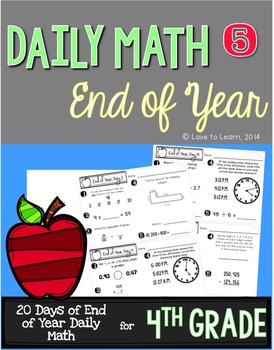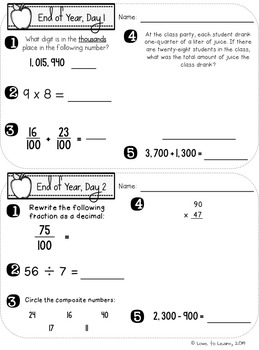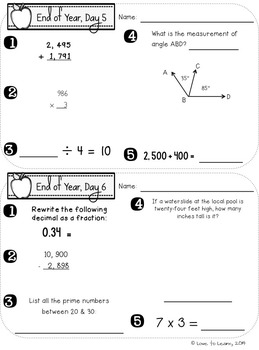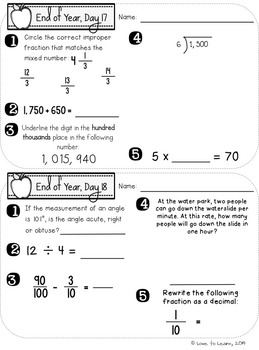Daily Math 5 (End of Year Review) Fourth Grade
Love to Learn and Teach
8k Followers
Grade Levels
3rd - 5th
Subjects
Resource Type
Standards
CCSS3.MD.A.1
CCSS4.MD.A.2
CCSS4.MD.A.3
CCSS4.MD.C.7
CCSS4.NBT.A.2
Formats Included
- PDF
Pages
16 pages
Love to Learn and Teach
8k Followers
What educators are saying
I used this as an end of the year review for Math concepts before our end of the school year last assessment. It was a great way to review the skills taught throughout the school year.
Also included in
- This unit contains all 6 of my Daily Math packs for fourth grade students. Used throughout the school year, these sheets are designed to spiral in difficulty, beginning with a review of Third Grade Common Core Standards in the Back to School pack and ending with a review of Fourth Grade Common CorePrice $18.00Original Price $20.00Save $2.00
Description
This unit is the fifth in my Fourth Grade Daily Math series. This unit contains 20 days of End of Year Review for 4th grade students. These sheets are created to provide students with independent practice of the fourth grade common core standards by the continued study of multiplication & division, fractions, angles, area & perimeter, decimals, place value, multi-digit addition & subtraction, telling time and money.
Some of the topics covered in this packet include:
- multiplication and division within 100.
- solving word problems involving the four operations.
- rounding numbers to any place.
- addition and subtraction within 1000.
- representing numbers in written and expanded forms.
- comparing and ordering numbers.
- double-digit multiplication.
- division with four-digit dividends and one-digit divisors.
- finding factor pairs.
- equivalent fractions.
- comparing fractions.
- addition and subtraction of fractions.
- converting mixed numbers and improper fractions.
- comparing decimals.
- expressing a fraction with denominator 10 as an equivalent fraction with denominator of 100.
- use decimal notation for fractions with denominators 10 or 100.
- telling time to the nearest minute.
- recognizing angle measure as additive.
Each page in this packet contains two days of Daily Math, with five questions for each day. Each day covers various Common Core Standards, in the attempt to provide students with a comprehensive review of skills.
These pages can be provided to students at the beginning of a math period, be placed in a math center for independent work, or can be given as homework to students in need of a skill review.
**Answer Keys included**
Please note that this unit is included in my Daily Math Fourth Grade Bundle Pack, which contains a full year of Daily Math: Daily Math Fourth Grade Bundle Pack
Thank you for looking!
- Love to Learn, 2013
Some of the topics covered in this packet include:
- multiplication and division within 100.
- solving word problems involving the four operations.
- rounding numbers to any place.
- addition and subtraction within 1000.
- representing numbers in written and expanded forms.
- comparing and ordering numbers.
- double-digit multiplication.
- division with four-digit dividends and one-digit divisors.
- finding factor pairs.
- equivalent fractions.
- comparing fractions.
- addition and subtraction of fractions.
- converting mixed numbers and improper fractions.
- comparing decimals.
- expressing a fraction with denominator 10 as an equivalent fraction with denominator of 100.
- use decimal notation for fractions with denominators 10 or 100.
- telling time to the nearest minute.
- recognizing angle measure as additive.
Each page in this packet contains two days of Daily Math, with five questions for each day. Each day covers various Common Core Standards, in the attempt to provide students with a comprehensive review of skills.
These pages can be provided to students at the beginning of a math period, be placed in a math center for independent work, or can be given as homework to students in need of a skill review.
**Answer Keys included**
Please note that this unit is included in my Daily Math Fourth Grade Bundle Pack, which contains a full year of Daily Math: Daily Math Fourth Grade Bundle Pack
Thank you for looking!
- Love to Learn, 2013
Total Pages
16 pages
Answer Key
Included
Teaching Duration
N/A
Last updated Jan 31st, 2013
Report this resource to TPT
Reported resources will be reviewed by our team. Report this resource to let us know if this resource violates TPT’s content guidelines.
Standards
to see state-specific standards (only available in the US).
CCSS3.MD.A.1
Tell and write time to the nearest minute and measure time intervals in minutes. Solve word problems involving addition and subtraction of time intervals in minutes, e.g., by representing the problem on a number line diagram.
CCSS4.MD.A.2
Use the four operations to solve word problems involving distances, intervals of time, liquid volumes, masses of objects, and money, including problems involving simple fractions or decimals, and problems that require expressing measurements given in a larger unit in terms of a smaller unit. Represent measurement quantities using diagrams such as number line diagrams that feature a measurement scale.
CCSS4.MD.A.3
Apply the area and perimeter formulas for rectangles in real world and mathematical problems. For example, find the width of a rectangular room given the area of the flooring and the length, by viewing the area formula as a multiplication equation with an unknown factor.
CCSS4.MD.C.7
Recognize angle measure as additive. When an angle is decomposed into non-overlapping parts, the angle measure of the whole is the sum of the angle measures of the parts. Solve addition and subtraction problems to find unknown angles on a diagram in real world and mathematical problems, e.g., by using an equation with a symbol for the unknown angle measure.
CCSS4.NBT.A.2
Read and write multi-digit whole numbers using base-ten numerals, number names, and expanded form. Compare two multi-digit numbers based on meanings of the digits in each place, using >, =, and < symbols to record the results of comparisons.






